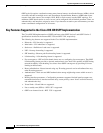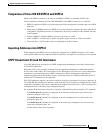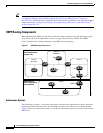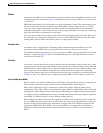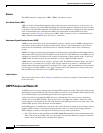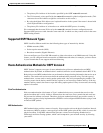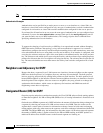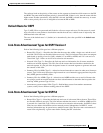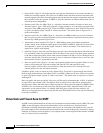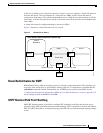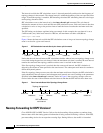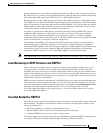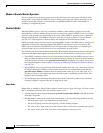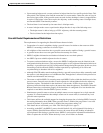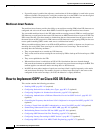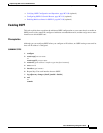
Implementing OSPF on Cisco IOS XR Software
Information About Implementing OSPF on Cisco IOS XR Software
RC-138
Cisco IOS XR Routing Configuration Guide
• Network LSA (Type 2)—Describes the link state and cost information for all routers attached to a
multiaccess network segment. This LSA lists all OSPF routers that have interfaces attached to the
network segment. Only the elected designated router for the network segment can generate and track
the network LSA for the segment. In OSPFv3, network LSAs have no address information and are
network-protocol-independent.
• Interarea-prefix LSA for ABRs (Type 3)—Advertises internal networks to routers in other areas
(interarea routes). Type 3 LSAs may represent a single network or set of networks aggregated into
one prefix. Only ABRs generate Type 3 LSAs. In OSPFv3, addresses for these LSAs are expressed
as “prefix and prefix length” instead of “address and mask.” The default route is expressed as a
prefix with length 0.
• Interarea-router LSA for ASBRs (Type 4)—Advertises an ASBR and the cost to reach it. Routers
that are trying to reach an external network use these advertisements to determine the best path to
the next hop. ABRs generate Type 4 LSAs.
• Autonomous system external LSA (Type 5)—Redistributes routes from another autonomous
system, usually from a different routing protocol into OSPF. In OSPFv3, addresses for these LSAs
are expressed as “prefix and prefix length” instead of “address and mask.” The default route is
expressed as a prefix with length 0.
• Link LSA (Type 8)—Has link-local flooding scope and is never flooded beyond the link with which
it is associated. Link LSAs provide the link-local address of the router to all other routers attached
to the link or network segment, inform other routers attached to the link of a list of IPv6 prefixes to
associate with the link, and allow the router to assert a collection of Options bits to associate with
the network LSA that is originated for the link.
• Intra-area-prefix LSAs (Type 9)—A router can originate multiple intra-area-prefix LSAs for every
router or transit network, each with a unique link-state ID. The link-state ID for each
intra-area-prefix LSA describes its association to either the router LSA or network LSA and
contains prefixes for stub and transit networks.
An address prefix occurs in almost all newly defined LSAs. The prefix is represented by three fields:
Prefix Length, Prefix Options, and Address Prefix. In OSPFv3, addresses for these LSAs are expressed
as “prefix and prefix length” instead of “address and mask.” The default route is expressed as a prefix
with length 0.
Inter-area-prefix and intra-area-prefix LSAs carry all IPv6 prefix information that, in IPv4, is included
in router LSAs and network LSAs. The Options field in certain LSAs (router LSAs, network LSAs,
interarea-router LSAs, and link LSAs) has been expanded to 24 bits to provide support for OSPF in IPv6.
In OSPFv3, the sole function of link-state ID in interarea-prefix LSAs, interarea-router LSAs, and
autonomous system external LSAs is to identify individual pieces of the link-state database. All
addresses or router IDs that are expressed by the link-state ID in OSPF Version 2 are carried in the body
of the LSA in OSPFv3.
Virtual Link and Transit Area for OSPF
In OSPF, routing information from all areas is first summarized to the backbone area by ABRs. The same
ABRs, in turn, propagate such received information to their attached areas. Such hierarchical
distribution of routing information requires that all areas be connected to the backbone area (Area 0).
Occasions might exist for which an area must be defined, but it cannot be physically connected to Area 0.
Examples of such an occasion might be if your company makes a new acquisition that includes an OSPF
area, or if Area 0 itself is partitioned.



